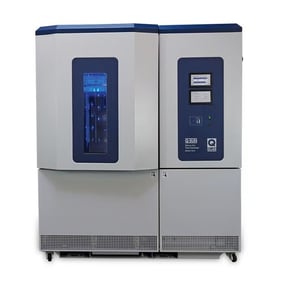This question sounds straightforward, but it is based on some erroneous assumptions. Generally the person asking this intends to take the light output of the testers (expressed in Langleys, joules, or Watts/m2) and divide it by the intensity of outdoor sunlight to get a magic factor for converting accelerated tester exposure hours into outdoor exposure years.
Unfortunately, there is no mathematically valid way to make such a calculation, because it runs counter to the most basic principles of accelerated weathering. (Not to mention that, by definition, the Langley refers only to the sun and not to other light sources.) The result of such a calculation is at best meaningless, and at worst totally misleading.
One reason such a computation is invalid is that it ignores the effect of wavelength. What determines the amount of photodegradation is not the total light dosage in joules, but rather, how those joules are distributed with respect to wavelength. A joule of UV light (short wavelength), for instance, can be more damaging than a joule of visible or infrared light (longer wavelength), depending on the material you are testing.
In addition, the amount of UV in sunlight varies quite a bit, which can have a tremendous effect on the weathering of samples. Langleys and joules fail to reflect the wide variations in solar UV that occur from season to season, day to day and, in fact, hour to hour. For this reason, a number of studies have shown that in successive outdoor exposures where replicate samples received the same exposure in Langleys, there can be as much as a 7:1 variation in the amount of damage produced. In other words, the Langley is too inconsistent to be used as a standard measure of outdoor exposure. The conclusion is clear: the Langley may have valid uses, but certainly not in the field of laboratory weathering.
Even a measurement of Total UV (TUV), such as the 'UV Langley' or 'UV joule,' may be misleading because the same reasoning applies: within the UV, shorter wavelengths generally cause faster degradation to durable materials.
Here is an example of the wrong conclusions you can get from using Langleys, joules, or even TUV to evaluate accelerated weathering testers. The QUV tester can use two types of lamps: UV-A lamps with a peak emission at a wavelength of 340 nm, or UV-B lamps with a peak at 313 nm. The UV-A lamps produce more joules (and more UV joules) than the UV-B lamps, so isn't it reasonable to deduce that the UV-A lamps will produce faster degradation? Not always. Many materials will degrade slower with UV-A lamps because the UV they produce is longer wavelength UV. In the Q-SUN tester, you will find these same variations depending on the filters used.
Another reason you can't compare the light intensities of the Q-SUN or the QUV testers with sunlight is that such procedures completely ignore the effect of moisture. We find that for many materials, the effects of rain and dew are more important than the effects of sunlight. This is often true even for phenomena like gloss loss and color change, which are sometimes considered to be UV-induced changes. If you don't take moisture into account, you can't possibly come up with a magic conversion factor.
Finally, a conversion computation based on light intensity is invalid because it ignores the effect of temperature. It is possible to choose a wide range of temperatures in an accelerated tester, and it is possible to have a wide range of temperatures in outdoor exposure. Temperature has a profound effect on the speed of photodegradation. We observe in our accelerated testers that in some cases a 10°C increase in test temperature can double the speed of degradation.
For more information, see Q-Lab Corporation technical bulletin LU-8030, Errors Caused by Using Joules to Time Laboratory and Outdoor Exposure Tests






